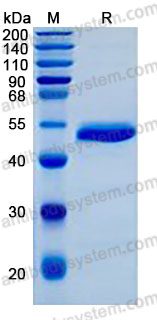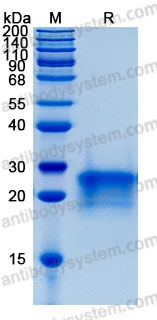Catalog No.
AHE95201
Biological activity
Immobilized human EphA7 at 0.5 μg/mL (100 μL/well) can bind human EFNA4 (Cat #: AHE95201) with a linear range of 0.039-0.942 ng/mL.
Expression system
Mammalian Cells
Species
Homo sapiens (Human)
Protein length
Leu26-Gly171
Nature
Recombinant
Endotoxin level
<0.1 EU/μg of the protein by the LAL method.
Purity
>90% as determined by SDS-PAGE.
Accession
P52798
Applications
Bioactivity, ELISA, Immunogen, SDS-PAGE, WB
Form
Lyophilized
Storage buffer
Lyophilized from a solution in PBS pH 7.4, 5% Trehalose, 5% Mannitol.
Reconstitution
Reconstitute in sterile water for a stock solution. A copy of datasheet will be provided with the products, please refer to it for details.
Shipping
In general, proteins are provided as lyophilized powder/frozen liquid. They are shipped out with dry ice/blue ice unless customers require otherwise.
Stability and Storage
Use a manual defrost freezer and avoid repeated freeze thaw cycles. Store at 2 to 8°C for one week. Store at -20 to -80°C for twelve months from the date of receipt.
Alternative Names
EPLG4, Ephrin-A4, LERK4, EFNA4, LERK-4, EPH-related receptor tyrosine kinase ligand 4
Calcitriol Modulates Hippocampal Axon Guidance Through Enhanced EfnA4-Mediated PI3K/AKT Signaling in an Autism Mouse Model., PMID:40395150
Linking obesity-associated genotype to child language development: the role of early-life neurology-related proteomics and brain myelination., PMID:39938231
EFNA4-enhanced deubiquitination of SLC7A11 inhibits ferroptosis in hepatocellular carcinoma., PMID:39656358
Eleven neurology-related proteins measured in serum are positively correlated to the severity of diabetic neuropathy., PMID:39048581
The EFNA4 gene is a potential prognostic biomarker in pancreatic cancer: a bioinformatics analysis., PMID:38989440
EFNA4 deletion suppresses the migration, invasion, stemness, and angiogenesis of gastric cancer cells through the inactivation of Pygo2/Wnt signaling., PMID:38953488
Alterations in the Circulating Proteome Associated with Albuminuria., PMID:36890639
Interference of EFNA4 suppresses cell proliferation, invasion and angiogenesis in hepatocellular carcinoma by downregulating PYGO2., PMID:36404439
TBX3 and EFNA4 Variant in a Family with Ulnar-Mammary Syndrome and Sagittal Craniosynostosis., PMID:36140816
Prospective Proteomic Study Identifies Potential Circulating Protein Biomarkers for Colorectal Cancer Risk., PMID:35805033
TrkB-dependent EphrinA reverse signaling regulates callosal axon fasciculate growth downstream of Neurod2/6., PMID:35462405
The Pan-Cancer Crosstalk Between the EFNA Family and Tumor Microenvironment for Prognosis and Immunotherapy of Gastric Cancer., PMID:35309935
De novo ALX4 variant detected in child with non-syndromic craniosynostosis., PMID:34586326
Plasma and urine biomarkers in chronic kidney disease: closer to clinical application., PMID:34475336
Comprehensive Search for Novel Circulating miRNAs and Axon Guidance Pathway Proteins Associated with Risk of ESKD in Diabetes., PMID:34140396
Identification of the hub genes and prognostic indicators of gastric cancer and correlation of indicators with tumor-infiltrating immune cell levels., PMID:34093807
Expression Pattern and Prognostic Value of EPHA/EFNA in Breast Cancer by Bioinformatics Analysis: Revealing Its Importance in Chemotherapy., PMID:33977106
Ephrin A4-ephrin receptor A10 signaling promotes cell migration and spheroid formation by upregulating NANOG expression in oral squamous cell carcinoma cells., PMID:33436772
Exposure to Mild Steel Welding and Changes in Serum Proteins With Putative Neurological Function-A Longitudinal Study., PMID:32984236
The EphA4 Signaling is Anti-catabolic in Synoviocytes but Pro-anabolic in Articular Chondrocytes., PMID:32816052
Sensitivity to differential NRF1 gene signatures contributes to breast cancer disparities., PMID:32705365
Pain-associated Mediators and Axon Pathfinders in Fibromyalgia Skin Cells., PMID:31203217
First-in-human, phase I study of PF-06647263, an anti-EFNA4 calicheamicin antibody-drug conjugate, in patients with advanced solid tumors., PMID:30680712
Reduced Corneal Innervation in the CD25 Null Model of Sjögren Syndrome., PMID:30513621
Identification of microRNA signature in the progression of gestational trophoblastic disease., PMID:29367697
A craniosynostosis massively parallel sequencing panel study in 309 Australian and New Zealand patients: findings and recommendations., PMID:29215649
Single suture craniosynostosis: Identification of rare variants in genes associated with syndromic forms., PMID:29168297
Molecular Analysis of Ephrin A4 and Ephrin B1 in a Rabbit Model of Craniosynostosis: Likely Exclusion as the Loci of Origin., PMID:28135115
Gene Expression Profiling of Muscle Stem Cells Identifies Novel Regulators of Postnatal Myogenesis., PMID:27446912
Anti-EFNA4 Calicheamicin Conjugates Effectively Target Triple-Negative Breast and Ovarian Tumor-Initiating Cells to Result in Sustained Tumor Regressions., PMID:26015513
A co-culture genome-wide RNAi screen with mammary epithelial cells reveals transmembrane signals required for growth and differentiation., PMID:25572802
EphrinB1 expression is dysregulated and promotes oncogenic signaling in medulloblastoma., PMID:25258252
EphA2 promotes infiltrative invasion of glioma stem cells in vivo through cross-talk with Akt and regulates stem cell properties., PMID:24488013
EphA4 receptor is a novel negative regulator of osteoclast activity., PMID:23983218
Detection of cadherin-17 in human colon cancer LIM1215 cell secretome and tumour xenograft-derived interstitial fluid and plasma., PMID:23557862
Decreased expression of axon-guidance receptors in the anterior cingulate cortex in autism., PMID:21859478
Eph-2B, acting as an extracellular ligand, induces differentiation markers in epidermal keratinocytes., PMID:21809346
Specific and shared targets of ephrin A signaling in epidermal keratinocytes., PMID:21193391
Expression profiling of protein tyrosine kinases and their ligand activators in leiomyoma uteri., PMID:20462350
Eph-ephrin bidirectional signaling comes into the context of lymphocyte transendothelial migration., PMID:20400865
An impaired transendothelial migration potential of chronic lymphocytic leukemia (CLL) cells can be linked to ephrin-A4 expression., PMID:19828693
A novel 1.4 Mb de novo microdeletion of chromosome 1q21.3 in a child with microcephaly, dysmorphic features and mental retardation., PMID:19772933
EphA4 as an effector of Twist1 in the guidance of osteogenic precursor cells during calvarial bone growth and in craniosynostosis., PMID:19201948
Expression profile of Eph receptors and ephrin ligands in healthy human B lymphocytes and chronic lymphocytic leukemia B-cells., PMID:18819711
Comparative integromics on Ephrin family., PMID:16596216
Cell mixing at a neural crest-mesoderm boundary and deficient ephrin-Eph signaling in the pathogenesis of craniosynostosis., PMID:16540516


